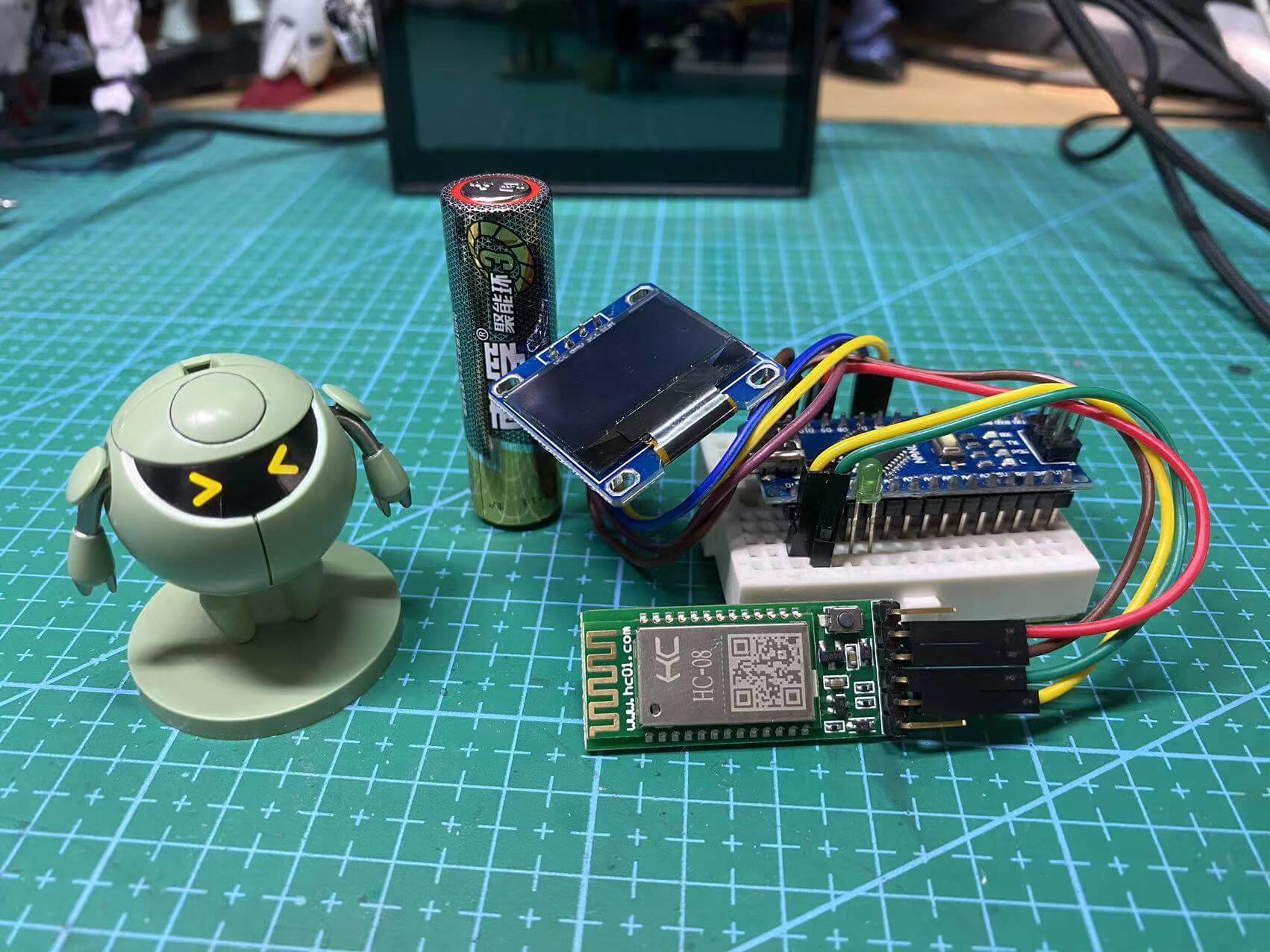产品部规划开发一款智能手表,通过蓝牙连接手机并实现一系列交互功能,因此我进行了一系列蓝牙传输技术调研。本文通过小程序蓝牙向 arduino 传输数据,实现简易版的蓝牙智能手表。

“智能手表” 的硬件配置
- 使用 arduino nano 开发板作为主控。
- 使用 0.96 寸 oled 屏幕作为手表的显示屏,用于显示从小程序传输的数据。
- 使用 HC-08 蓝牙低功耗模块进行蓝牙传输。
- 面包板、杜邦线等连接线材,本文省略接线过程。
烧写 arduino 控制代码
arduino 烧写代码是通过 usb 接口连接到电脑,使用 arduino IDE 进行代码上传。
ardunio 的控制代码使用 c 语言,在本项目中需要引入 Adafruit_GFX 和 Adafruit_SSD1306 库,这两个库用于驱动 oled 屏幕显示,需要在 IDE 中安装这两个库并引入;而 Wire 库可以让Arduino与IIC设备进行通信,这块 0.96 寸的 oled 屏幕使用的就是 IIC 通讯协议,这个库是内置库,直接引入即可。对于蓝牙模块,不需要额外的驱动程序,因为蓝牙模块只需要把数据通过串口传输到 arduino,对串口数据进行监听即可。
代码及相关注释如下:
// 引入IIC通讯所需的Wire库文件
#include <Wire.h>
// 引入驱动OLED0.96所需的库
#include <Adafruit_GFX.h>
#include <Adafruit_SSD1306.h>
#define SCREEN_WIDTH 128 // 设置OLED宽度,单位:像素
#define SCREEN_HEIGHT 64 // 设置OLED高度,单位:像素
// 自定义重置引脚
#define OLED_RESET 4
Adafruit_SSD1306 display(SCREEN_WIDTH, SCREEN_HEIGHT, &Wire, OLED_RESET);
char data = 0;
void setup()
{
// 初始化OLED并设置其IIC地址为 0x3C
display.begin(SSD1306_SWITCHCAPVCC, 0x3C);
Serial.begin(9600);
}
void loop()
{
words_display();
display.display();
}
void words_display()
{
if(Serial.available() > 0) { // 串口有数据则开始读取
display.clearDisplay(); // 清除屏幕
display.setTextColor(WHITE); // 设置字体颜色
display.setTextSize(2); // 设置字体大小
display.setCursor(0, 0); // 设置光标位置
String tmp = ""; // 临时字符串变量,保存串口接收到的数据
while(Serial.available() > 0) {
data = Serial.read();
tmp+=data;
delay(15); // 解决字符串丢失问题
}
Serial.print(tmp); // 向串口回复数据
display.print(tmp); // 在显示屏显示数据
}
}使用小程序进行蓝牙通讯
根据小程序官方文档,小程序对 BLE(蓝牙低功耗)支持度比较高,也符合“智能手表”的数据交互使用场景,因此以小程序作为蓝牙通讯的测试平台。
首先安装小程序开发者工具,创建一个 typescript 项目,并手动接入 vue-mini 库,这个库可以把 vue3 响应式能力应用在原生小程序开发中,在工作中也有应用。
以下是蓝牙通讯小程序所需 ts 代码:
import { definePage, reactive } from '@vue-mini/wechat'
import { str2Ascii } from '@/utils/common'
import { formatTime } from '@/utils/util'
definePage({
setup() {
const state = reactive({
input: '',
deviceId: '',
serviceId: '',
characteristicId: '',
interval: 0
})
// ArrayBuffer 转换为字符串
function ab2str(buf: ArrayBuffer) {
return String.fromCharCode.apply(null, new Uint8Array(buf) as unknown as number[]);
}
async function init() {
// 开启蓝牙适配器
await wx.openBluetoothAdapter({
mode: 'central'
}).then(res => {
console.log('openBluetoothAdapter', res)
}).catch(err => {
console.log('openBluetoothAdapter err', err)
})
// 开始扫描蓝牙设备
await wx.startBluetoothDevicesDiscovery({
interval: 1000,
}).then(res => {
console.log('startBluetoothDevicesDiscovery', res)
}).catch(err => {
console.log('startBluetoothDevicesDiscovery err', err)
})
}
// 找到 HC-08 蓝牙模块
wx.onBluetoothDeviceFound(res => {
res.devices.forEach(divice => {
if(divice.name === 'HC-08') {
console.log('onBluetoothDeviceFound', res)
console.log('this is hc-08 ', divice)
wx.stopBluetoothDevicesDiscovery()
state.deviceId = divice.deviceId
connect(divice.deviceId)
}
})
})
// 建立连接,获取 3 个重要的id
async function connect(deviceId: string) {
await wx.createBLEConnection({ deviceId })
const { services } = await wx.getBLEDeviceServices({ deviceId })
console.log('services', services)
const targetService = services[services.length - 1]
console.log('targetService', targetService)
const serviceId = targetService.uuid
state.serviceId = serviceId
const { characteristics } = await wx.getBLEDeviceCharacteristics({ deviceId, serviceId })
console.log('characteristics', characteristics)
const characteristic = characteristics[0]
state.characteristicId = characteristic.uuid
if(characteristic.properties.write) {
if (characteristic.properties.notify || characteristic.properties.indicate) {
// 必须先启用 wx.notifyBLECharacteristicValueChange 才能监听到设备 onBLECharacteristicValueChange 事件
wx.notifyBLECharacteristicValueChange({
deviceId,
serviceId,
characteristicId: characteristic.uuid,
state: true,
})
}
wx.writeBLECharacteristicValue({
deviceId,
serviceId,
characteristicId: characteristic.uuid,
value: str2Ascii('hello world'), // 向蓝牙串口写入 hello world
})
wx.showToast({
title: '初始化成功',
icon: 'success',
duration: 1000
})
}
}
// 监听串口返回的数据,可以收到回复的 hello world
wx.onBLECharacteristicValueChange((result) => {
console.log('result', result, ab2hex(result.value))
console.log('str', ab2str(result.value))
})
function onInput(e: WechatMiniprogram.CustomEvent) {
state.input = e.detail.value
}
// 发送字符串
async function onSubmit() {
console.log(state.input)
await wx.writeBLECharacteristicValue({
deviceId: state.deviceId,
serviceId: state.serviceId,
characteristicId: state.characteristicId,
value: str2Ascii(state.input)
})
wx.showToast({
title: '发送成功',
icon: 'success',
duration: 1000
})
}
// 实现“手表”显示时间
async function showTime() {
state.interval = setInterval(() => {
const time = formatTime(new Date())
wx.writeBLECharacteristicValue({
deviceId: state.deviceId,
serviceId: state.serviceId,
characteristicId: state.characteristicId,
value: str2Ascii(time)
})
}, 1000)
}
function stopTime() {
clearInterval(state.interval)
}
init()
return {
state,
onSubmit,
onInput,
showTime,
stopTime
}
},
})以下是 wxml 部分
<view class="page">
<view>请输入</view>
<view class="input-wrap">
<input type="text" class="input" value="{{state.input}}" bind:input="onInput"></input>
</view>
<button type="primary" bindtap="onSubmit">上传</button>
<button bindtap="showTime">显示时间</button>
<button bindtap="stopTime">stop</button>
</view>“智能手表” 最终效果
正确连接线路(arduino、蓝牙模块、oled 模块),并给 arduino 模块通电启动。此时蓝牙模块将进入待机状态,等待连接。
打开小程序,小程序将会自动连接到 HC-08 蓝牙模块,连接成功后小程序将会有
初始化成功提示。此时 oled 屏幕上显示hello world。在小程序输入框中输入任意文字(仅限 ASCII 码),点击上传按钮,即可在 oled 屏幕上显示对应的文字。
点击“显示时间”按钮,小程序将会每隔 1s 发送当前时间到 arduino,在 oled 屏幕上将会显示每秒变化的时间。
Q&A
- 为什么只能传输 ASCII 码,可以传输中文吗?
受限于 arduino 储存空间(32KB),默认只能显示 ASCII 码。对部分中文字体进行编码,可以实现有限的中文显示。还可以使用自带字体库的屏幕模块。
- 为什么传输的是 ArrayBuffer?
蓝牙传输和 oled 屏数据传输都是采用串口通讯,串口通信的数据传输都是0和1,只能传输二进制数据。对于 ASCII 码,一个字符占用1bit,因此对应 js 中的数据结构是Uint8Array。